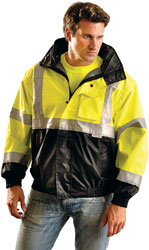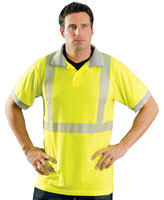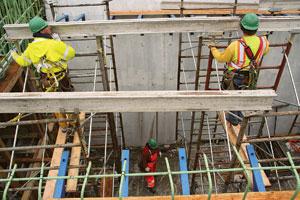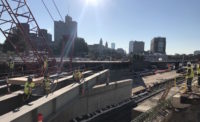Imagine all the parkas, pullovers and polo shirts in this season’s L.L. Bean catalog in neon green or orange, and you have what many jobsites will look like when a federal regulation hits later this month. Safety suppliers are redesigning high-visibility clothes to be functional as well as (dare we say?) fashionable.
 Bomber’s black strips cut down the ‘dirty-jacket look.’
( Photo courtesy of Occunomix International LLC) |
Stipulated in the 2005 highway bill and set for implementation on Nov. 24, a federal rule will require any worker in the right of way of a federal-aid highway, day or night, to wear high-visibility garments with Class 2 or Class 3 labels. Clothes must be certified to meet International Safety Equipment Association standard ISEA 107-2004. Class types vary in their amount of fluorescent fabric and reflective tape.
The Federal Highway Administration rule is all-inclusive: Police, emergency, news media and construction crews, including equipment operators, surveyors and flaggers, will need to suit up. Garments must withstand at least 25 washes, according to the standard.
Since the rule was published, various options have emerged to fit an individual’s job, comfort and taste. Ninety percent of workers have been complying with the rule since it was written, says FHWA. But the mandate, which is aimed at reducing injuries in which workers are struck by oncoming traffic or heavy equipment, has had the effect of making “high-viz” clothing fashionable.
“Some people think that construction workers don’t care about style, but it seems like they do,” says Jennifer McCoy, director of marketing for OccuNomix International LLC. It sells a high-viz-yellow bomber jacket that has black fabric covering typically high-wear areas over the midsection and cuffs to eliminate that “dirty-jacket look,” says the product catalog. “That was more of a fashion statement than for any other reason, and it has been our runaway best seller,” McCoy says. List price: $101.50.
 |
 Tudor Van Hampton / ENR
|
Construction workers on I-35W bridge project wore a variety of high-viz clothing, from jackets to vests. (Photo left courtesy of Occunomix International LLC) | |
Even the boring, basic $20 safety vest is getting a makeover, with more utility pockets, smooth zippers, breathable mesh and trim that is more forgiving and less “crunchy” when workers move. Suppliers stress that vests are just one of many options available now. “We are not saying that safety vests are bad,” says Gary Pearson, marketing manager for Minneapolis-based 3M. “We’re just saying the end-user should not make it their only choice.”
Clothes that “work with you instead of against you” are in style, adds Chris Wojnar, product manager for Portland, Ore.-based LaCrosse Footwear. Later this month, it will launch new high-viz mesh vests and moisture-wicking T-shirts. Sweatshirts and long-sleeve shirts will follow suit.
Contractors already are showing brighter colors. At the fast-paced Interstate-35W bridge rebuild that wrapped up this summer in Minneapolis, ENR spotted high-viz everywhere, from basic safety vests to insulated jackets. “Safety? We live by it,” says Jon Chiglo, Minnesota Dept. of Transportation project manager. Premium high-performance fabrics and stretchable reflective tape also allow for company logos on garments to make safety more marketable, suppliers say.
Hardhats are not included in the rule, but users should consider buying them, notes Jim Byrnes, product manager for Pittsburgh-based MSA. No high-viz standard exists for headgear, but one is expected as soon as next month. “We recommend you use a high-viz helmet with at least 12 in. of reflectivity,” he says.


Post a comment to this article
Report Abusive Comment